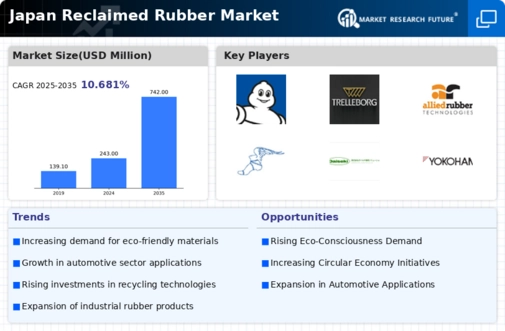The reclaimed rubber market in Japan is characterized by a competitive landscape that is increasingly shaped by sustainability initiatives and technological advancements. Key players such as Bridgestone Corporation (Japan), Mitsubishi Chemical Corporation (Japan), and Sumitomo Rubber Industries (Japan) are at the forefront of this evolution. Bridgestone Corporation (Japan) has positioned itself as a leader in innovation, focusing on developing eco-friendly products and enhancing its recycling processes. Meanwhile, Mitsubishi Chemical Corporation (Japan) emphasizes strategic partnerships to bolster its supply chain and expand its market reach, while Sumitomo Rubber Industries (Japan) is actively pursuing digital transformation to optimize its manufacturing capabilities. Collectively, these strategies indicate a shift towards a more sustainable and technologically advanced competitive environment.
In terms of business tactics, companies are increasingly localizing manufacturing to reduce transportation costs and enhance supply chain efficiency. The market structure appears moderately fragmented, with several players vying for market share. However, the influence of major companies is significant, as they set industry standards and drive innovation. This competitive dynamic fosters an environment where smaller firms must adapt quickly to remain relevant, often leading to collaborations or niche market strategies.
In November 2025, Bridgestone Corporation (Japan) announced a partnership with a leading technology firm to develop advanced recycling technologies aimed at increasing the recovery rate of rubber materials. This strategic move is likely to enhance Bridgestone's sustainability profile and position it as a pioneer in the circular economy within the industry. The collaboration underscores the importance of technological innovation in meeting environmental goals and responding to consumer demand for sustainable products.
In October 2025, Mitsubishi Chemical Corporation (Japan) launched a new line of reclaimed rubber products designed specifically for the automotive sector. This initiative not only diversifies their product offerings but also aligns with the growing trend of eco-conscious manufacturing in the automotive industry. By targeting this sector, Mitsubishi Chemical Corporation (Japan) is likely to capture a significant share of the market, as automotive manufacturers increasingly seek sustainable materials to meet regulatory requirements and consumer expectations.
In September 2025, Sumitomo Rubber Industries (Japan) unveiled a comprehensive digital strategy aimed at enhancing operational efficiency through AI and data analytics. This initiative is expected to streamline production processes and improve product quality, thereby strengthening Sumitomo's competitive position. The integration of digital technologies into manufacturing processes reflects a broader trend within the industry, where companies are leveraging data to drive decision-making and optimize performance.
As of December 2025, the competitive trends in the reclaimed rubber market are heavily influenced by digitalization, sustainability, and the integration of AI technologies. Strategic alliances are becoming increasingly vital, as companies recognize the need to collaborate to enhance their capabilities and market presence. Looking ahead, it appears that competitive differentiation will evolve from traditional price-based competition to a focus on innovation, technological advancement, and supply chain reliability. This shift suggests that companies that prioritize sustainable practices and technological integration are likely to emerge as leaders in the market.





















Leave a Comment